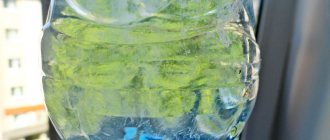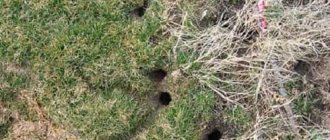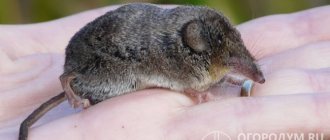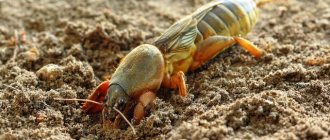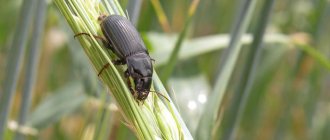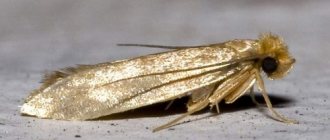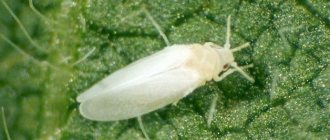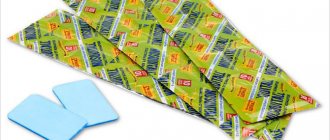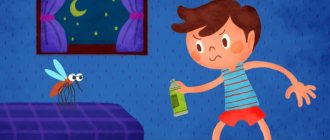Flies, like mosquitoes, are part of the order Diptera (Diptera), class Insects. They have two front wings, the hind wings have been transformed into balance organs - halteres.
Dipterologists (Diptera specialists) cannot name the exact number of species. It is known that 28 families of these insects number over 30 thousand groups.
Interesting fact. In a list of new species of plants and animals released by Australian scientists in 2022, some flies were named after heroes of the MARVEL multiverse.
Types and habitat of insects
Representatives of Diptera are distributed everywhere, except Antarctica and the Arctic zone, and live in the wild and near humans. The latter are called synanthropic and are divided into 3 groups:
- village: habitat – populated areas, for example, Musca domestica (indoor);
- semi-settlement: live and reproduce in settlements and in nature – Callphoridae (meat-bearing);
- pasture: develop in the droppings of cows and sheep on pasture - Wohlfahrtia magnifica (Wohlfahrtia).
Families and species
Dipterologists today distinguish the following groups:
Calliphoridae (Carrion)
- Calliphora vicina (blue redhead).
- Calliphora uralensis (blue meat).
- Lucilia sericata Mg. and Lucilia illustris Mg. (species of the genus green blowfly).
Area – Russia, Wed. Asia, Caucasus, Europe, North. America. The larvae of some species develop in carrion and cattle burial grounds no more than 1 meter deep, while others develop in cesspools. Adults feed on meat waste, feces, and fruits. You can meet them at bazaars and slaughterhouses.
Piophilidae (Cheese)
Scientists name about 100 species. Distributed everywhere, especially in areas where fishing is carried out. Fish, cheese, lard are the best places for the development of larvae, which grow up to 8 millimeters. If disturbed, they can jump up to 150mm.
Hippoboscidae (Bloodsuckers)
They live everywhere. There are about 800 species. Adult flies are blood-sucking. With paws equipped with serrated claws, they cling to birds, deer, dogs and other animals. Sometimes they attack people, causing skin inflammation.
Sarcophagidae (Grey meats)
Distribution: Europe, Asia, North Africa. There are approximately 3 thousand species. It reproduces on corpses, feces, manure, and food waste. Adult flies eat feces, meat, and fruits.
One of the most dangerous representatives of the family is the Wohlfart fly. She lays larvae on open wounds. By eating living tissue, parasites cause severe pain.
Oestridae (Gadflies)
Pasture insects. Maggots develop on the body of livestock and humans.
- Hypodermatinae (Subcutaneous). Doesn't live only in the Far North. The larvae penetrate the skin into the body and move through the tissues, causing skin lesions.
- Gasterophilinae (Stomach). Lives everywhere. Larvae enter the gastrointestinal tract with food and lead to inflammation of the stomach.
- Oestrinae (Cavity, nasopharyngeal). The larvae enter the mucous membranes, and from there into the pharynx and frontal sinuses, leading to miasma.
Drosophilidae (Drosophila)
Distributed everywhere. Midges can be seen in flower pots and bird nests. There are 1.5 thousand species. They feed on rotting plants. Maggots develop in spoiled vegetables and fruits, compotes, juices: apple, cherry, grape.
The most famous type. There are more than 5 thousand species in the world. The most common in Russia are:
- market;
- autumn fireweed;
- Room, house.
Danger to humans
Larvae of the genus Eristalis are not parasites. But beekeeper eggs laid on food can be swallowed by humans. When swimming in a dirty pond, there is a possibility that larvae may enter the body. An alternative option for infection is the female laying eggs near the anus. Being in the rectum, it irritates the walls of the organ with its breathing tube. The resulting myiasis is called eristalosis. The disease has been registered in India, Australia, South America and some European countries - Denmark, Belgium, Spain.
Symptoms of the disease: diarrhea, vomiting, abdominal pain, itching in the anus. In some cases, symptoms do not appear. The disease is treated with medication, metronidazole and nifuroxazide are prescribed.
House fly
Another name is room. There are 2 subspecies found on the territory of the Russian Federation: Musca domestica domestica (common) and Musca domestica vicina (southern).
Homeland - steppe regions Wed. Asia, but today it is widespread everywhere. Active mainly during the daytime. The life cycle is 8-20 days. Acceptable temperature is 23-25 degrees Celsius.
Important. Some specimens can survive the winter in an unheated room in an inactive state and continue activity as soon as the temperature rises to 10 degrees.
Insects are carriers of gastrointestinal diseases, tuberculosis, worms, and eye diseases. May cause serious tissue damage (myiases)
Morphology
Three sections of the body: chest, abdomen, head - are densely covered with hairs. The body of an adult is 6-8 mm, gray in color. The lower part of the abdomen is yellowish, along the top of the chest there are 4 longitudinal stripes.
On the chest there are three pairs of five-segmented limbs. The last segment has suction cups that help it move along walls and ceilings. The organs of taste and touch are also located here.
There are large compound eyes on the head, followed by 3 simple ocelli. The distance between the eyes is smaller in males than in females. In front are antennae, which are designed for orientation in space and sense of smell.
Licking-sucking oral apparatus - proboscis and jaws. Flies can only consume liquid food; solid food is first dissolved in saliva. Therefore, contrary to speculation, they cannot pierce human skin and drink blood. During the period of egg maturation, the female switches to protein food. How do flies appear?
Ilnitsa-beeweed (tenacious Ilnitsa)
This type of fly belongs to the hoverfly family. In appearance they are similar to an ordinary bee. The average length is 1.5 cm. The abdomen is dark brown in color, covered with plumage of small hairs; on the side there are large red spots with a yellowish tint. In the middle part of the fly's face there is a wide, well-developed shiny black stripe. Before our eyes - two
vertical stripes with thick hair. The hind limbs in the lower leg area are also covered with hairs. The insect's thighs are almost black.
The larva of the bee moth is dark with a gray tint. The body of the larvae has a cylindrical shape and reaches a length of 10–20 mm. The larva breathes using a special breathing tube, which can stretch up to 100 mm in length. This organ is very important for her, since she lives in conditions of fetid liquids, garbage pits and pond sewage, and can only breathe clean air.
This insect is active from July to October. Illices feed on the nectar of various flowering plants.
Beeworm larvae can be the source of a dangerous intestinal disease found in some European countries, Africa, Australia, Chile, Argentina, India, Iran and Brazil.
The disease occurs as a result of fly eggs entering the human intestines along with food. There the larva hatches and begins to develop, causing enteritis.
Stages of development
The number of stages is influenced by the type of development of the fly - viviparous or oviparous.
Most often it occurs in the following sequence:
- egg;
- larva (3 periods);
- chrysalis;
- imago (adult).
There is no first phase in viviparous species. The larvae develop in the abdomen of the female. A prominent representative is the gray blowfly.
Most insects are oviparous: houseflies, botflies, fruit flies and others.
Diptera are very fertile. The female can lay more than 100 eggs, and reproduction continues throughout her short life. During the year, 9-20 generations can change.
Preventive measures
To prevent blowflies from breeding, you must follow certain rules:
- In places where the garbage can is located, the soil must be concreted and asphalt laid. This will prevent the larvae from completing their life cycle.
- It is necessary to ensure timely disposal and removal of waste that attracts insects with the smell of rotting. During the warm season, you need to take out the trash from your apartment every day.
- Do not leave meat products lying on tables. To prevent females from laying eggs or maggots, you need lard and rub the meat with salt. The best option is to quickly put it in the freezer. Beef, pork, chicken, etc. may be affected.
- If you want to cook lightly salted fish, you should add more salt to the brine than is required in the cold season. In this way, the product can be protected from malicious worms.
- In the warm season, it is recommended to install mosquito nets on windows and doors, which will protect against many pests from entering the house.
- On livestock and poultry farms, it is necessary to ensure sewage drainage.
To prevent disease and intestinal infection, you need to strictly follow the rules of personal hygiene and food handling. Wash your hands with soap, rinse vegetables, fruits, and herbs thoroughly under running water or pour boiling water over them.
Laying eggs
How are houseflies born? It all starts with mating. Males use sounds made by their halteres to attract females. Individuals copulate.
For oviposition, the female chooses places that are most favorable for this stage of fly development: manure, human waste, carrion, cesspools, rotten meat, spoiled fruits and vegetables. Through the ovipositor, which is located at the end of the abdomen, it can lay 70-120 white eggs approximately 1.2 millimeters long at a time. Depending on the weather, representatives of the order Diptera are capable of laying up to 2 thousand eggs throughout their lives.
For a note. Not all insects manage to survive at all stages of development, hence such high fertility. Next, postembryonic development begins, which occurs in stages.
How does the larva develop?
The embryo is freed from the shell, and a white legless larva appears, which many mistakenly call a worm or caterpillar. Length - about 13 millimeters, pointed in front, truncated in back.
The formation of the larva takes place in 3 stages. On the third, the yellowish-white body becomes shiny and spines appear on it.
Maggots feed on the environment where the eggs were laid. They do not have a digestive system, so they absorb processed food after releasing a caustic substance.
The cycle is completed in 3-25 days, for some, for example, the humpback, up to 4 weeks. The maggot finds a cool place where metamorphosis begins - the pupa is born.
Pupa stage
The most passive period in fly breeding. The membrane hardens and a puparium is formed. Pupae cannot tolerate heat (over +40 degrees) and high humidity. If the ground does not dry out for a long time after rain, they die. Therefore, during the rainy seasons there are few flies.
Under favorable conditions, the tissues in the cocoon disintegrate and changes in the whole organism occur. After about 5 days at a temperature of +25 degrees, an adult individual appears - an imago, which after 36 hours is capable of reproducing offspring.
By summing up the time allotted by nature for each stage, you can find out how quickly house flies reproduce: from one week to a month.
Lifespan
As we already understood from the previous chapters of our review, the total lifespan of a fly can be 10-30 days. Having summed up all the stages of the life cycle during which the development of a fly occurs from birth as an egg to the death of an adult winged individual, we arrive at exactly this general period.
What factors influence the lifespan of a buzzing parasite? First of all, the temperature regime of its habitat. The insect can live in conditions from 10 to 40 degrees, but the optimal range is 18-25 degrees.
The life of a fly can last much longer than several weeks, especially if the insect managed to survive the winter period. Some particularly lucky individuals can live for 2 months, but this is still largely an exception.
Features of the reproductive organ
There are growths and formations on the male genitals. Charles Darwin tried to describe their function by examining an individual through a microscope. The scientist believed that they were needed to more successfully persuade a female to have sexual intercourse, as well as to get rid of the sperm of the previous partner.
Modern dipterologists have experimentally proven that education is needed in order to attract partners to copulation and not slip off when they mate.
Features of female reproductive organs
Each of the two large ovaries is a connection of oviducts, which are divided into segments in which follicles develop (in which the egg is formed). The process begins in the pupal stage and ends in the adult stage.
When the female lays eggs, the accessory glands connect to the oviduct and secrete a secretion with which the eggs are glued to the nutrient medium.
Viviparous species
This group includes almost all blowflies, including the Wohlfart fly, as well as the famous killer fly, the tsetse.
How do viviparous (carrion, blow) flies reproduce? They lay larvae of the first stage in fish, meat, feces, corpses, as well as in abrasions and wounds on the skin of people and animals. After 5-7 days, the larvae hide in the ground, away from light and heat, and turn into a pupa, and then into an adult.
On a note. Carrion species have been well studied, and this is successfully used by criminologists: if larvae are found on a corpse, then the time of death can be determined.
Gadflies
In nature, there are 30 genera, including 176 species. They are often confused with horseflies, bumblebees and bees.
Appearance
Body length is 9 mm-2.5 cm. An adult has a wide head with large eyes and short antennae. There is no proboscis, or it is reduced. The legs are massive and short. The abdomen is round or conical. The entire body is covered with coarse hairs. The life of gadflies is short - approximately 22 days.
Classification
- Hypodermatinae (Subcutaneous). Adults lay eggs on the hair of domestic animals: horses, rams, cows. The hatched larvae penetrate the skin and move through the tissues. Before entering stage II, they gather under the skin, forming inflamed fistulas. Through them the larvae get to the surface.
- Gasterophilinae (Stomach). There are 2 ways for larvae to enter. Some females lay eggs on leaf food, and they enter the animal with food. Others - on the head and chest. The cattle, by biting and licking the skin, transfer the eggs into the digestive tract.
- Oestrinae (Cavity, nasopharyngeal). Females release eggs in flight, which land on the mucous membranes of the eyes and nose. People often suffer unwittingly: as a result, conjunctivitis (very dangerous for a child) and other diseases can develop.
Some scientists classify Cuterebrinae, the American subcutaneous gadfly, as a separate subfamily. They most often parasitize mice, hares, gophers, etc.
Danger to humans
Some subcutaneous species, such as Dermatobia hominis, attack humans. Bodfly larvae penetrate the skin, causing a lot of suffering. Cases have been recorded where a person died from the penetration of parasites.
Gadflies are inventive in attack: some distract, others attack. Their legs are soft, so you may not notice when a fly lands on your skin. But its bite is very painful, burning. Redness appears in this place and itching begins.
Human blood serves as a breeding ground for eggs. The hatched larvae, looking for a way out, move upward. If they get into the brain, death is inevitable.
Effective means
A huge variety of substances have been produced and invented to combat flies. Such means can be insecticides, repellers, indoor plants, and traps. Below we will look at the most popular of them.
Agita
The product is intended for treating large rooms. It has proven itself well in the fight against insects living in pigsties and cowsheds. Non-toxic to humans and livestock.
The substance contains pheromones for attraction and thiamethoxam, which has a detrimental effect on flies. Before use, you must dilute the powder in water. Apply the resulting solution to the walls of the room in wide strips using a brush. Pests attracted by pheromones will land on treated surfaces and die after eating the insecticide.
Agita is sold in four hundred gram packaging, which is enough to process 160 square meters. m. Cost – 2300 rub.
Get
Sold in liquid form, packaged in 100 ml containers. Affects both adults and larvae. The substance belongs to toxicity class 4 and only in certain cases can cause harm to humans. Get destroys flies outright.
Horpyfiros, which is part of the composition, is enclosed in microcapsules made of polymer. Due to this, the product remains effective for 6–12 months.
Before use, dilute the concentrated solution in water and then spray on areas where flies congregate. Carry out processing following the precautions indicated on the packaging. Average price – 800 rub.
Alfatsin
In most cases, it is used by sanitation workers, as it requires compliance with certain safety measures. You should not carry out the processing yourself. Suitable for treating premises of any purpose. The drug can kill not only flies, but also ants, fleas and cockroaches.
The product is sold in liquid form, packaged in containers of 1, 5, 20 or 25 liters. Before application, it is necessary to dilute the toxic emulsion with water in appropriate proportions.
Evil TED
The product is intended to kill flies and wasps. It is not prohibited to use the substance yourself. The ready-to-use liquid contains pheromones to attract pests and an insecticide to kill them.
Carry out the procedure as carefully as possible, apply the substance only to those places where it can then be washed off. Alternatively, you can spray the product onto sheets of paper and then dispose of them.
Cucaracha emulsion concentrate
The substance has intestinal contact effects. This means that if liquid gets into the intestinal cavity or even onto the insect’s cover, sudden death is inevitable.
The product has a strong unpleasant odor, but is suitable for independent use in residential areas.
FlyByte
The drug works as bait and is available in the form of a granular substance. The pheromones included in the composition attract insects, and insecticides, after eating the granules, cause irreversible harm to their body.
Sprinkle the powder into small containers, such as saucers, and place them in areas where flies are abundant. For a better effect, you can add a little water to the plate with the drug.
Minap 22
Fights all types of insects living in human homes. The product is used mainly by professional exterminators, as it requires maximum compliance with safety measures. Begins to affect insects in the first 24 hours after treatment.
Executioner
It proved to be excellent in the fight against fly larvae. Capable of exterminating the entire population of adult individuals. Suitable for treating any surfaces with which humans come into contact.
Poisonous Velcro
One of the most popular means is Velcro. They are inexpensive, and the effect is quite noticeable, although they do not look very aesthetically pleasing. This is a tape impregnated with pheromones to attract insects, coated with an adhesive substance containing an insecticide.
Pull the ring and remove the tape from the tube. Hang the unrolled Velcro in rooms where there is high fly activity. Pests, attracted by the pleasant aroma for them, will land on the surface of the tape, stick and, having eaten the poison, die. Once the Velcro has become sufficiently full of insects, it must be disposed of.
Such devices are not capable of removing the entire population of insects, but can significantly reduce its numbers. Choose a location for the Velcro away from the dining table and food, as sometimes flies come off and fall off.
Fumigators
They work by heating plates or liquid, emitting toxic fumes. The device requires an electrical connection to operate. The substance in the plates is considered non-toxic, but the manufacturer does not recommend that children, allergy sufferers, and asthmatics be kept closer than 1 meter.
Insert the plate or screw the bottle with liquid into a specially designated place in the fumigator, plug the device into a power outlet. The effect of 1 plate lasts for 12–24 hours. After treating the room, disconnect the device from the power supply.
Crayons
They are highly effective in small spaces. To exterminate pests, draw small stripes in places where they are most concentrated. If a fly touches the substance, it will die immediately. It is not advisable to use crayons in homes where there are children or pets.
Electronic fly repellent
The second name is electric fly swatter. If a fly lands on the device, it receives a current charge, which leads to its instant death. To operate the device, you only need to insert the plug into the outlet.
Ultrasonic repellers
They work based on the emission of ultrasonic waves, which are intolerable to insects. Applicable only to enclosed spaces, apartments or houses. The waves produced repel insects. At the same time, their effect does not affect a person in any way. To operate the device, a connection to an electrical network is required.
Spirals
The spiral is impregnated with a caustic substance, which enters the air during smoldering and repels insects. For exposure, light the tip of the spiral and blow out the flame so that the substance begins to smolder. Place the device in areas where flies are most active.
Sources
- https://klopkan.ru/muhi/lichinki-muh-gde-muhi-otkladyvayut-yaytsa-kak-oni-vyglyadyat-i-kak-nazyvayutsya-2/
- https://WikiParazit.ru/babochki-i-moshki/lichinki-muh-v-cheloveke.html
- https://kopejsk.ru/opisanie/yajtsa-i-lichinki-muh-foto-i-opisanie.html
- https://WikiParazit.ru/babochki-i-moshki/razvitie-muhi.html
- https://belt-wrestling.su/muhi-i-moshki/mangrovaya-muha.html
- https://notklop.ru/muhi/2-fakty/22-yajca-i-lichinki-muh/
- https://VrediteliSOS.ru/nasekomye/muhi/komnatnaya-muha.html
- https://parazitdoma.ru/drugie-parazity/lichinki-muh
- https://hoznauka.ru/vrediteli/kak-izbavitsya-ot-muh.html
[collapse]
Meaning in nature
Despite the fact that flies are annoying insects that poison human life, they play an important role in nature.
- Representatives of Diptera are one of the links in the food chain. Let’s assume that this is a favorite treat for the flycatcher.
- The larvae process rotting waste, cleaning the planet and returning minerals to the soil.
- Many types of flies pollinate plants. For example, in spring and summer you can find a hoverfly or an ear fly feeding on the nectar of flower stalks.
Interesting fact. During the war, it was noticed that wounds on which fly larvae were deposited healed faster. The thing is that maggots secrete digestive juice, which destroys bacteria and dead tissue.
Feeding maggots
Eggs and larvae of flies
Synanthropic insects feed on decaying organic matter and sour juices. Their food source is human food, crumbs, garbage in a trash can, feces, rotting vegetables, fruits, and plants. The same food is necessary for the larvae.
Blowflies develop on dead, rotting tissues of animals and humans, as well as in feces, manure, pus, and garbage cans. The larvae help the corpses decompose, thereby bringing extreme benefits. At the last stage of their development, they burrow into the soil and pupate.
Fly larvae do not have a digestive system; they absorb already digested food. To do this, they initially release a caustic, aggressive chemical that dissolves any organic tissue, after which the prepared food is absorbed.
Interesting!
Maggots live in an extremely dangerous environment, which is teeming with pathogens. They themselves do not get sick, they produce the strongest antibiotic - seraticin, to which pathogens are not able to develop immunity. The larvae stop the rotting of tissues, so they are used in medicine to treat poorly healing wounds. Maggots are specially raised under sterile conditions.
Prevention
Insects harm gardens, vegetable gardens, and park areas; young cuttings, leaves, and shoots, which people lovingly grow, especially suffer from the larvae.
In addition, flies are carriers of dangerous diseases. Breeding these insects is not worthwhile, so you need to follow simple rules:
- carry out regular cleaning;
- Take out the trash can every day, which must always be closed;
- do not leave food waste on the table;
- seal fruits, vegetables, meat, fish or put them in the refrigerator;
- monitor the condition of mosquito nets.
Knowing the patterns and characteristics of the reproduction of flies, you can choose effective means of combating them.
Methods of controlling pest numbers
Flies are carriers of gastrointestinal diseases. Therefore, the appearance of such neighbors in the house is extremely undesirable. Read about how to make fly traps here.
In order to protect yourself and your home as much as possible from these insects, you need to follow simple rules:
- get rid of garbage in a timely manner, especially organic waste;
- to prevent insects from entering, use mosquito nets on windows;
- keep your home clean;
- use chemical means for destruction;
- residents of private houses, farmers, keep the premises for animals clean, inspect them for open wounds, and also keep the compost pit closed.
Knowing how these unpleasant insects reproduce, you can prevent their widespread spread throughout the house, apartment or area.

